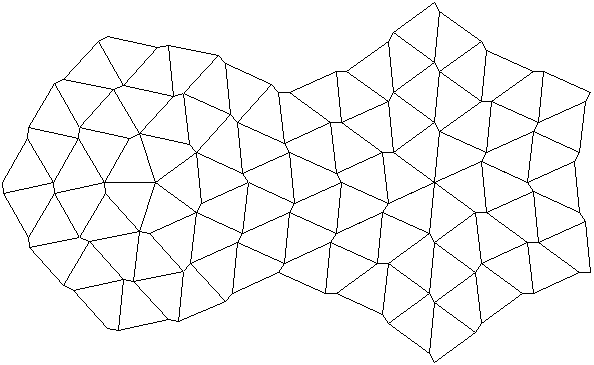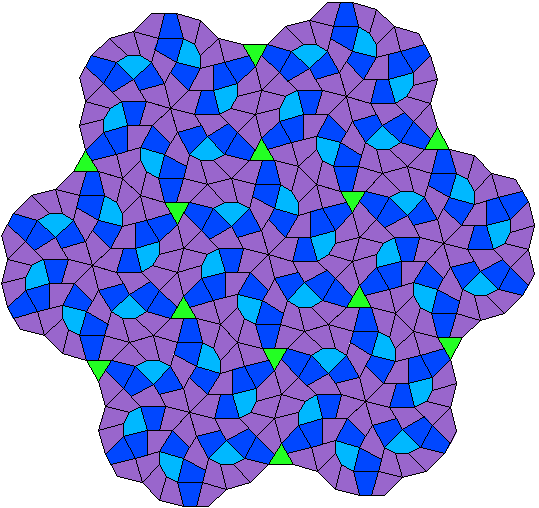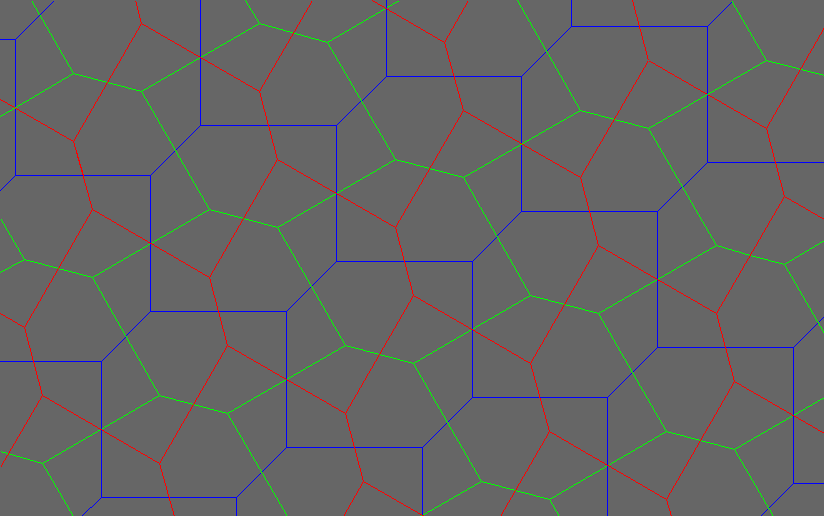


The Mitre System set and Frames. Patented by Adrian Fisher
and Ed Pegg Jr.
Origins

Core Shapes and Supporting Shapes of The Mitre System.
Patent
Pending by Adrian Fisher and Ed Pegg Jr. For more on the shapes,
click
here.
by Adrian Fisher,
Ed
Pegg Jr, and Miroslav
Vicher
Back in 1998, I (EPJ) noticed the Fisher Pavers over at Adrian's
site. I considered these carefully designed heptagons and squares
quite clever. They could make some very nice designs, but I didn't
find them chaotic enough. So, I started playing with Autocad LT,
trying to find something better.



These images of the Fisher Paver System are copyright
(c) 2000 by Adrian Fisher. Used with permission.
My first finding was a pentagon that could be put together to make an 18-gon.
This turned out to be the Hirschhorn Medalion. When I tried putting
two medalions together, I only needed one extra piece to tile the plane
chaotically.

This image of Ed Pegg's Chaos Tile system is copyright
(c) 1998 by Ed Pegg Jr.
I shared this with Adrian a bit tauntingly. "Your Fisher Pavers are
nice, but they can't make chaotic patterns." This began a long correspondence.
My Chaos Tiles were nice, but doing the edging would be dreadful.
He suggested that this was one of the reasons that the Penrose Tiles weren't
widely used. If you look at the edges of the rectangle above, you'll
see a tile-worker's nightmare. After a lot of e-mails and phone calls,
the following Rules of Decorative Bricks were decided upon:
1. No fault lines across the tessellation in any direction.
2. Ability to make squares and rectangles.
3. No sharp angles -- they break too easily
4. Under a modular layout, the ability to lay out a design
with minimal cutting.
5. Spirals and other curves should be possible by using
differently colored bricks.
6. The tiling should be able to interface with the modules
of other tiling systems.
7. The tiling should use few pieces.
8. The ability to make both periodic and nonperiodic
designs is desirable.
9. The pieces must be of similar size. (Dodecagons
and triangles won't work for weight-bearing floors)

Semiregular Dodecagon-Triangle design by Archimedes.
Can you find all 8 semiregular tessellations?
Both of us were intrigued by the results of dividing the 18-gon (Chaos
Tiles) and 10-gon (Penrose System), so we started trying to find interesting
ways to cut up n-gons. All of the following designs can be extended
into spectacular tessellations, but most cannot make squares or rectangles.
It is well known that any n-gon can be divided into rhombi, but we were
interested in using a minimal number of pieces. Greg
Frederickson talks about this a bit in his dissections book. What is
the largest n-gon that can be divided nicely, like these? To avoid
an obvious answer, the minimal angle on any piece must be greater than
30 degrees.

n-gon dissections copyright (c) 1998 by Adrian Fisher
and Ed Pegg Jr. The 20-gon isn't regular, the others are.
We had a lot of fun tossing designs back and forth at each other.
In the meantime, I contracted Kadon
Enterprises to lasercut some of the pieces of Chaos Tiles for me.
Soon, I had a bag of botched pieces (my fault - I sent the wrong angles).
Turns out that this piece could make 24-gons, when squares were added.
More importantly, half of this piece had a very nice property -- It could
make squares! Thus started the Mitre System. The date was 18
December 1998 by this point. Earlier, I had discovered an almost
square with a single piece. Adrian was finding lots of fascinating
patterns, but didn't see the square. So I sent it to him.


Design C1853 copyright (c) 1998 by Adrian Fisher.
Used with permission. 20-piece Square copyright (c) 1998 by Ed Pegg
Jr.
He responded almost immediately with the Terrazzo Tiling, which used the
same pieces to make a larger square. I didn't expect this.

Terrazzo Tiling design copyright (c) 1998 by Adrian Fisher.
Used with permission.
We called this original piece the Pyramid (hint: squint). We eventually
decided that the best way to fill in the small square was to extend the
existing piece to make a new piece we called the Fin. While trying
to find large nested squares, we ran into difficulties. Adrian solved
the problem by using some 30-60-90 triangles, but I didn't like it.
I suggested the shape of a piece that might work, but then later sent Adrian
the sad news that it wouldn't work. He wrote me back to tell me I
was wrong -- the piece DID work! It worked wonderfully! Indeed,
the three pieces allowed us to make all manner of nested shapes.

Nested Squares using the Mitre System copyright (c) 1998
by Ed Pegg Jr.
We called the new piece the Mitre. Using all three pieces, a wide variety
of squares and rectangles of can be made, all with elaborate, beautiful
designs. We also found a variety of supporting pieces that worked
very well with the core shapes. Later, we filed a patent on the system.
Investigating patents at the US
Patent & Trademark Office was interesting. Patent 4133152
is the Penrose Tiling system.

A variety of squares using the Mitre System copyright
(c) 1999 by Ed Pegg Jr, Adrian Fisher, and Miroslav Vicher. Used
with permission.
In addition to discovering a variety of squares, we also found hexagons
and dodecagons. Due to a quirk in the construction, the same set
of pieces can be used to almost perfectly fill large rectangles of any
size -- if the rectangle is large enough. This feature allows tile to be
laid with much less cutting. Hexagonal layouts are possible with
many patterns.

A variety of hexagons using the Mitre System copyright
(c) 1999 by Ed Pegg Jr and Adrian Fisher. Used with permission.
For hexagonal tilings, the Bell shape proved very useful. Depending
on the needs of a particular tiling design, a number of supporting shapes
were formalized. Follow this link to
a page detailing more shapes.
I'd gotten to know Miroslav Vicher when he started solving a variety
of difficult tiling problems, such as Eternity. After Adrian and
I filed the patent, we hired Mira to look for solutions with this system
using his program, and he found thousands. Do
look at Miroslav Vicher's site, for more. For example, the following
is one of over ten thousand dodecagon patterns he found. He
found many squares and rectangles that eluded us, and a wide variety of
beautiful tessellations.

Dodecagon using the Mitre System copyright (c) 1999 by
Miroslav Vicher. Used with permission.
Much interest has been shown in the Mitre System for decorative design.
This page is a mere taste of what we've found. After our contact
information, you'll see an example of a modularized Mitre System layout.
There are more
designs by Adrian Fisher available.
For actual paving and house design, this
page describes the different scale systems.
For all inquiries, please contact:
Adrian Fisher, Victoria Lodge, 5 Victoria Grove, Portsmouth,
PO5 1NE, England.
Phone: +44 23 9235 5500 Email: adrian@mazemaker.com

Fountain copyright (c) 2000 by Adrian Fisher. Used with
permission.
New Tessellation Systems
You can see Semiregular tessellations here
(by M. Vicher). Pentagons that tile the plane are here.
Chaim Goodman-Strauss wrote
a page on tessellations. There's a program called Tessellmania.
M C Escher liked them. Andrew
Crompton likes them. Robert Fathauer sells tessellations at www.tessellations.com.
Kadon Enterprises also sells them.
Patent 4,133,152 was awarded to Sir Roger Penrose for a tessellation. Adrian
Fisher has patent 5,945,181. There are 187 patented tessellations
listed at the US Patent Office.
Both Chaos Tiles and the Mitre
System have been awarded a patent.
But none of the above links gives either of the following tessellations,
both done with the same shape. This quadrilateral can tile the plane
with either five-fold symmetry or six-fold symmetry.
 There are many other interesting single tile tessellations. For example,
Michael Dowle has done an extensive study on Iamond
tessellations. Here is a new page by him on Enneiamond
tessellations. You can also look at Michael's other tessellation
pages on Small Iamonds, Hexiamonds,Heptiamonds,
Octiamonds,
and Radial/Random Tessellations.
In a similar vein, Michael Reid has a page on
rectifiable
polyominoes. The
Poly Pages by Andrew Clarke has a section on tessellations.
There are many other interesting single tile tessellations. For example,
Michael Dowle has done an extensive study on Iamond
tessellations. Here is a new page by him on Enneiamond
tessellations. You can also look at Michael's other tessellation
pages on Small Iamonds, Hexiamonds,Heptiamonds,
Octiamonds,
and Radial/Random Tessellations.
In a similar vein, Michael Reid has a page on
rectifiable
polyominoes. The
Poly Pages by Andrew Clarke has a section on tessellations.
When I made the Chaos Tiles, I found a large
number of interesting tessellations based on the nonagon. Here's
one of them.
 By putting paths on these pieces, complex looking celtic knots can be made.
How many different pieces are required for the following figure? For the really
adventuresome puzzle solvers, I'd like a flawless celtic knot for the 30-gon,
with a minimal number of pieces.
By putting paths on these pieces, complex looking celtic knots can be made.
How many different pieces are required for the following figure? For the really
adventuresome puzzle solvers, I'd like a flawless celtic knot for the 30-gon,
with a minimal number of pieces.
 One of the bonuses of The
Mitre System is the seemingly infinite number of beautiful patterns.
Miroslav
Vicher found many. Here is one I found, with fans, pyramids,
corks, and a few triangles.
One of the bonuses of The
Mitre System is the seemingly infinite number of beautiful patterns.
Miroslav
Vicher found many. Here is one I found, with fans, pyramids,
corks, and a few triangles.
 I liked that pattern, but I felt it was possible to use fewer shapes.
Here is a Mitre System
tiling that just uses two shapes, and an occasional third.
I liked that pattern, but I felt it was possible to use fewer shapes.
Here is a Mitre System
tiling that just uses two shapes, and an occasional third.
 To me, it seems like there is still much to know about tessellations.
Much beauty remains to be discovered. Time passes... and now it's
the next day. This new shape, in purple, seemed promising.
It was. The below pattern uses only pyramids and the new shape, dubbed
the Millstone.
To me, it seems like there is still much to know about tessellations.
Much beauty remains to be discovered. Time passes... and now it's
the next day. This new shape, in purple, seemed promising.
It was. The below pattern uses only pyramids and the new shape, dubbed
the Millstone.























